STIHL HS 56, HS 46 Owner's Manual
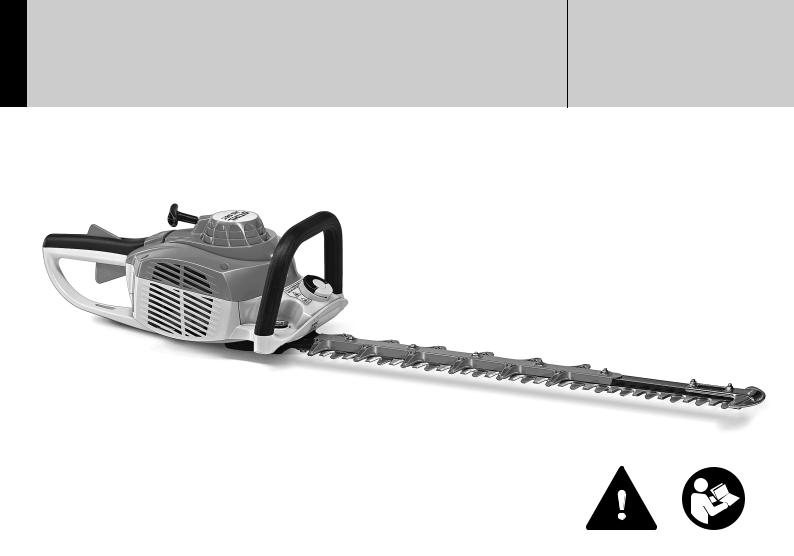
{
STIHL HS 46, 56
Instruction Manual
Manual de instrucciones
 WARNING
WARNING
Read and follow all safety precautions in Instruction Manual – improper use can cause serious or fatal injury.
 ADVERTENCIA
ADVERTENCIA
Lea y siga todas las precauciones de seguridad dadas en el manual de instrucciones – el uso incorrecto puede causar lesiones graves o mortales.
Instruction Manual 1 - 33
Manual de instrucciones 34 - 70
English
Contents
Printing inks contain vegetable oils, paper can be recycled.
Printed on chlorine-free paper Original Instruction Manual
© ANDREAS STIHL AG & Co. KG, 2013 0458-447-8621-A. VA3.E13. 0000005085_005_GB
Guide to Using this Manual |
2 |
Safety Precautions and Working |
|
Techniques |
2 |
Using the Unit |
10 |
Fuel |
11 |
Fueling |
12 |
Starting / Stopping the Engine |
14 |
Operating Instructions |
17 |
Cleaning the Air Filter |
17 |
Engine Management |
17 |
Adjusting the Carburetor |
18 |
Spark Arresting Screen in Muffler |
19 |
Checking the Spark Plug |
19 |
Lubricating the Gearbox |
20 |
Rewind Starter |
21 |
Storing the Machine |
21 |
Sharpening Instructions |
22 |
Maintenance and Care |
23 |
Main Parts |
25 |
Specifications |
26 |
Special Accessories |
27 |
Maintenance and Repairs |
28 |
Disposal |
28 |
STIHL Incorporated Federal |
|
Emission Control Warranty |
|
Statement |
28 |
STIHL Incorporated California |
|
Exhaust and Evaporative |
|
Emissions Control Warranty |
|
Statement |
30 |
Trademarks |
33 |
Allowonlypersonswhofullyunderstand this manual to operate your hedge trimmer.
To receive maximum performance and satisfaction from your STIHL hedge trimmer, it is important that you read, understand and follow the safety precautions and the operating and maintenance instructions in chapter "Safety Precautions and Working Techniques" before using your hedge trimmer. For further information you can go to www.stihlusa.com.
Contactyour STIHLdealer or theSTIHL distributor for your area if you do not understandanyoftheinstructionsinthis manual.
 WARNING
WARNING
Because a hedge trimmer is a highspeed cutting tool some special safety precautionsmustbeobservedtoreduce the risk of personal injury. Careless or improperusemaycauseseriousoreven fatal injury.
{This instruction manual is protected by copyright. All rights reserved, especially the rights to reproduce, translate and process with electronic systems.
HS 46, HS 46 C, HS 56 C |
1 |
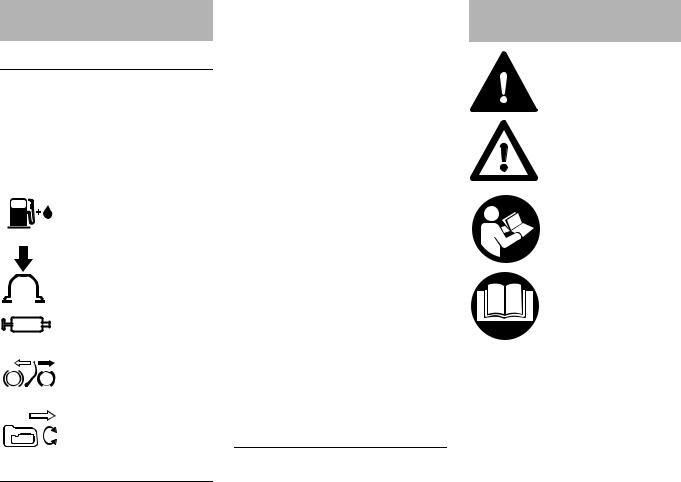
English
Guide to Using this Manual
Pictograms
The meanings of the pictograms attached to or embossed on the machine are explained in this manual.
Dependingonthemodelconcerned,the following pictograms may be on your machine.
Fuel tank for gasoline and engine oil mixture
Press to operate manual fuel pump
Filler hole for gear lubricant
Starting lock
Rotating rear handle
Symbols in Text
Many operating and safety instructions are supported by illustrations.
The individual steps or procedures describedinthe manualmaybe marked in different ways:
N A bullet marks a step or procedure.
2
A description of a step or procedure that refers directly to an illustration may contain item numbers that appear in the illustration. Example:
N Loosen the screw (1). N Lever (2) ...
In addition to the operating instructions, this manual may contain paragraphs that require your special attention. Such paragraphs are marked with the symbols and signal words described below:
 DANGER
DANGER
Indicates an imminent risk of severe or fatal injury.
 WARNING
WARNING
Indicates a hazardous situation which, if not avoided, could result in severe or fatal injury.
NOTICE
Indicates a risk of property damage, including damage to the machine or its individual components.
Engineering Improvements
STIHL’s philosophy is to continually improve all of its products. As a result, engineeringchangesandimprovements are made from time to time. Therefore, some changes, modifications and improvements may not be covered in this manual. If the operating characteristics or the appearance of your machine differs from those describedinthismanual,pleasecontact your STIHL dealer for assistance.
Safety Precautions and
Working Techniques
Because a hedge trim- mer is a high-speed, fastcutting power tool with sharp cutting blades, special safety precau- tions must be observed to reduce the risk of per- sonal injury.
It is important that you read, fully understand and observe the following safety precautions and warnings. Read the instruction manual and the safety precautions periodically. Careless or improper use may cause serious or fatal injury.
Have your STIHL dealer show you how to operate your power tool. Observe all applicable local safety regulations, standards and ordinances.
 WARNING
WARNING
Do not lend or rent your power tool without the instruction manual. Be sure that anyone using it understands the information contained in this manual.
 WARNING
WARNING
The use of this machine may be hazardous. If the cutting tool comes in contact with your body, it will cut you.
HS 46, HS 46 C, HS 56 C

Use your hedge trimmer only for cutting hedges, shrubs, scrub, bushes and similar material.
 WARNING
WARNING
Do not use it for other purposes, since misuse may result in personal injury or property damage, including damage to the machine.
 WARNING
WARNING
Minors should never be allowed to use this power tool. Bystanders, especially children, and animals should not be allowed in the area where it is in use.
 WARNING
WARNING
Toreducetheriskofinjurytobystanders and damage to property, never let your power tool run unattended. When it is not in use (e.g. during a work break), shut it off and make sure that unauthorized persons do not use it.
Most of these safety precautions and warnings apply to the use of all STIHL hedge trimmers. Different models may have different parts and controls. See the appropriate section of your instruction manual for a description of the controls andthefunctionoftheparts of your model.
Safe use of a hedge trimmer involves
1.the operator
2.the power tool
3.the use of the power tool.
HS 46, HS 46 C, HS 56 C
THE OPERATOR
Physical Condition
You must be in good physical condition and mental health and not under the influence of any substance (drugs, alcohol, etc.) which might impair vision, dexterity or judgment. Do not operate this machine when you are fatigued.
 WARNING
WARNING
Be alert – if you get tired, take a break. Tiredness may result in loss of control. Working with any power tool can be strenuous.Ifyouhaveanyconditionthat mightbeaggravatedbystrenuouswork, check with your doctor before operating this machine.
 WARNING
WARNING
Prolonged use of a power tool (or other machines) exposing the operator to vibrations may produce whitefinger disease (Raynaud's phenomenon) or carpal tunnel syndrome.
These conditions reduce the hand's ability to feel and regulate temperature, produce numbness and burning sensations and may cause nerve and circulation damage and tissue necrosis.
All factors which contribute to whitefinger disease are not known, but cold weather, smoking and diseases or physical conditions that affect blood vessels and blood transport, as well as high vibration levels and long periods of
English
exposure to vibration are mentioned as factorsinthedevelopmentofwhitefinger disease. In order to reduce the risk of whitefinger disease and carpal tunnel syndrome, please note the following:
–Most STIHL power tools are available with an anti-vibration ("AV") system designed to reduce the transmission of vibrations created by the machine to the operator's hands. An AV system is recommended for those persons using power tools on a regular or sustained basis.
–Wear gloves and keep your hands warm.
–Keep the AV system well maintained. A power tool with loose components or with damaged or worn AV elements will tend to have higher vibration levels.
–Maintain a firm grip at all times, but do not squeeze the handles with constant, excessive pressure. Take frequent breaks.
All the above-mentioned precautions do not guarantee that you will not sustain whitefinger disease or carpal tunnel syndrome. Therefore, continual and regular users should closely monitor the condition of their hands and fingers. If any of the above symptoms appear, seek medical advice immediately.
 WARNING
WARNING
The ignition system of the STIHL unit produces an electromagnetic field of a very low intensity. This field may interfere with some pacemakers. To reduce the risk of serious or fatal injury, persons with a pacemaker should
3
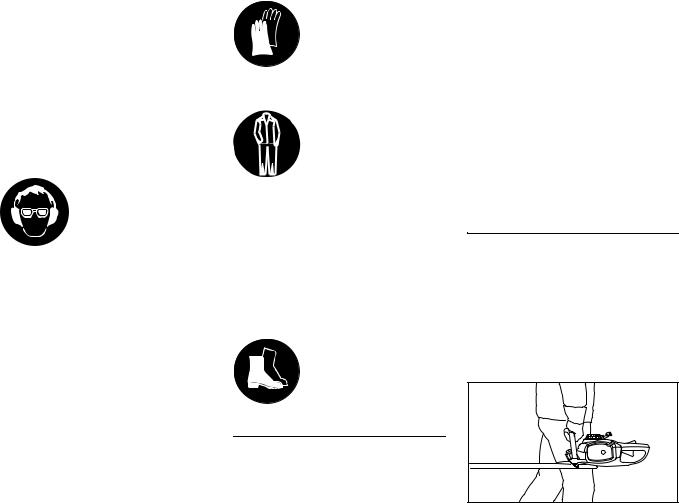
English
consult their physician and the pacemaker manufacturer before operating this tool.
Proper Clothing
 WARNING
WARNING
To reduce the risk of injury, the operator should wear proper protective apparel.
 WARNING
WARNING
To reduce the risk of injury to your eyes never
operate your power tool unless wearing goggles or properly fitted protec- tive glasses with adequate top and side protection complying with ANSI Z 87.1 (or your applicable national stand- ard.) If there is a risk of facial injury, STIHL rec- ommends that you also wear a face shield or face screen over your gog- gles or protective glasses.
Power tool noise may damage your hearing. Wear sound barriers (ear plugs or ear mufflers) to protect your hearing. Continual and regular users should have their hearing checked regularly.
Be particularly alert and cautious when wearing hearing protection because your ability to hear warnings (shouts, alarms, etc.) is restricted.
Always wear gloves when handling the machine and the cutting tool. Heavy-duty, nonslip gloves improve your grip and help to protect your hands.
Clothing must be sturdy and snug-fitting, but allow
complete freedom of movement. Wear long pants made of heavy material to help protect your legs. Do not wear shorts, sandals or go barefoot.
Avoid loose-fitting jackets, scarfs, neckties, jewelry, flared or cuffed pants, unconfined long hair or anything that could become caught on branches, brush or the moving parts of the unit. Secure hair so it is above shoulder level.
Good footing is very important. Wear sturdy boots with nonslip soles. Steel-toed safety boots are recommended.
THE POWER TOOL
For illustrations and definitions of the power tool parts see the chapter on "Main Parts."
 WARNING
WARNING
Nevermodifythispowertoolinanyway. Only attachments supplied by STIHL or expressly approved by STIHL for use with the specific STIHL model are authorized. Although certain
unauthorized attachments are useable with STIHL power tools, their use may, in fact, be extremely dangerous.
If this tool is subjected to unusually high loads for which it was not designed (e.g. heavy impact or a fall), always check that it is in good condition before continuing work.Checkin particularthat the fuel system is tight (no leaks) and that the controls and safety devices are working properly. Do not continue operating this machine if it is damaged. Incaseofdoubt,haveitcheckedbyyour STIHL servicing dealer.
THE USE OF THE POWER TOOL
Transporting the Power Tool
 WARNING
WARNING
To reduce the risk of injury from blade contact, never carry or transport your power tool with the cutting blades moving.
0008BA024 KN |
It may be carried only in the horizontal position. Grip the front handle and keep thehotmufflerawayfromyourbodyand the cutting blades behind you.
4 |
HS 46, HS 46 C, HS 56 C |

 WARNING
WARNING
Always switch off the engine and fit the scabbard over the cutting blades before transporting the power tool over long distances. When transporting it in a vehicle, properly secure it to prevent turnover, fuel spillage and damage to the unit.
Fuel
Your STIHL power tool uses an oilgasoline mixture for fuel (see the chapter on "Fuel" of your instruction manual.)
 WARNING
WARNING
Gasoline is an extremely flammable fuel. If spilled and ignited by a spark or other ignition source, it can cause fire and seri-
ous burn injury or property damage. Use extreme caution when handling gasoline or fuel mix. Do not smoke or bring any fire or flame near the fuel or the power tool. Note that combusti- ble fuel vapor may escape from the fuel system.
Fueling Instructions
 WARNING
WARNING
Fuel your power tool in well-ventilated areas, outdoors. Always shut off the engine and allow it to cool before refueling. Gasoline vapor pressure may
HS 46, HS 46 C, HS 56 C
build up inside the fuel tank depending on the fuel used, the weather conditions and the tank venting system.
In order to reduce the risk of burns and other personal injury from escaping gas vapor and fumes, remove the fuel filler caponyourpowertoolcarefullysoasto allow any pressure build-up in the tank to releaseslowly.Neverremove thefuel filler cap while the engine is running.
Selectbare groundforfuelingandmove at least 10 feet (3 m) from the fueling spot before starting the engine. Wipe off any spilled fuel before starting your machine.
 WARNING
WARNING
Check for fuel leakage while refueling and during operation. If fuel leakage is found, do not start or run the engine until the leak is fixed and any spilled fuel has been wiped away. Take care not to get fuel on your clothing. If this happens, change your clothing immediately.
 WARNING
WARNING
Inordertoreducetheriskoffuelspillage and fire from an improperly tightened fuel cap, correctly position and tighten the fuel cap in the fuel tank opening.
English
Toolless cap with grip
001BA234 KN
To do this with this STIHL cap, raise the griponthetopofthecapuntilitisupright at a 90° angle. Insert the cap in the fuel tank opening with the positioning mark on the grip of the cap and on the fuel tank opening lining up. Using the grip, pressthecapdownfirmlywhileturningit clockwise as far as it will go
(approx. 1/4 turn).
Fold the grip flush with the top of the cap. Grip 



 the cap and check for tightness. If the grip does not lie completely flush
the cap and check for tightness. If the grip does not lie completely flush
with the cap and the detent on the grip does not fit in the correspond- ing recess in the filler opening, or if the cap is loose in the filler opening, the cap is not properly seated and tightened and you must repeat the above steps.
Misaligned, damaged or broken cap
NIfthecapdoesnotdropfullyintothe openingwhenthepositioningmarks line up and/or if the cap does not tighten properly when twisted, the baseofthecapmaybeprematurely rotated (in relation to the top) to the closed position. Such misalignment
5
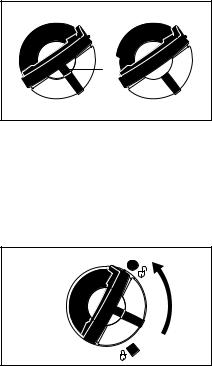
English
can result from handling, cleaning or an improper attempt at tightening.
|
1 |
|
001BA238KN |
Left: |
Bottom of cap is twisted – |
|
inner mark (1) in line with |
|
outer mark. |
Right: |
Bottom of cap in correct posi- |
|
tion –innermarkisunderthe |
|
grip. It is not in line with the |
|
outer mark. |
001BA239 KN
NTo return the cap to the open position for installation, turn the cap (with the grip up) until it drops fully intothetankopening.Next,twistthe capcounterclockwiseasfarasitwill go (approx. 1/4 turn) – this will twist
6
the base of the cap into the correct position. Then, twist the cap clockwise, closing it normally.
NIf your cap still does not tighten properly, it may be damaged or broken; immediately stop use of the unit and take it to your authorized STIHL dealer for repair.
See also the "Fueling" chapter in your Instruction Manual for additional information.
Before Starting
 WARNING
WARNING
Alwayscheck yourpowertool forproper condition and operation before starting. The Master Control lever must move easily in direction of STOP or †and spring back to the normal run position F. Action of Master Control lever, throttle trigger lockout and throttle trigger must be smooth – the throttle trigger must return automatically to the idle position. The Master Control lever must spring backfromthelandnpositionstothe normal run position Fwhen the throttle trigger lockout and throttle trigger are squeezed. Never attempt to modify the controls or safety devices.
 WARNING
WARNING
Never use a power tool that is damaged or not properly maintained.
 WARNING
WARNING
Check that the spark plug boot is securely mounted on the spark plug – a loose boot may cause arcing that could ignite combustible fumes and cause a fire.
Keep the handles clean and dry at all times; it is particularly important to keep themfreeofmoisture,pitch,oil,fuelmix, grease or resin in order for you to maintain a firm grip and properly control your power tool.
 WARNING
WARNING
The cutting blades must be properly tightened and in safe operating condition. Inspect for loose parts (nuts, screws, etc.) and for cracked, bent, warped or damaged blades. Regularly check the condition and tightness of the cuttingblades–withtheenginestopped! Replacedamagedcuttingbladesbefore using the power tool. Always keep blades sharp.
STIHL recommends that you always spray the cutting blades with STIHL resin solvent before starting work – with the engine stopped! You can obtain this protectivesprayfromyourSTIHLdealer. Apply generously.
Starting
Start the engine at least 10 feet (3 m) from the fueling spot, outdoors only.
Forspecificstartinginstructions,seethe chapter "starting / stopping the engine" of your instruction manual. Place the power tool on firm ground or other solid surface in an open area. Maintain good balance and secure footing.
 WARNING
WARNING
To reduce the risk of injury from blade contact, be absolutely sure that the cutting blades are clear of you and all otherobstructionsandobjects,including the ground, because when the engine
HS 46, HS 46 C, HS 56 C
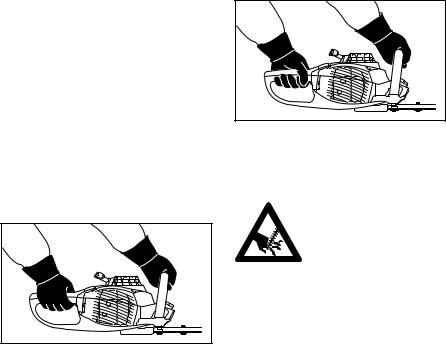
starts at starting-throttle, engine speed will be fast enough for the clutch to engage and move the blades on the cutting tool.
Once the engine has started, immediately blip the throttle trigger, whichshouldreleasethestartingthrottle and allow the engine to slow down to idle.
 WARNING
WARNING
Your power tool is a one-person machine. Do not allow other persons in the general work area, even when starting.
 WARNING
WARNING
To reduce the risk of injury from loss of control, do not attempt to "drop start" your power tool.
 WARNING
WARNING
When you pull the starter grip, do not wrap the starter rope around your hand. Do not let the grip snap back, but guide the starter rope to rewind it properly. Failure to follow this procedure may result in injury to your hand or fingers and may damage the starter mechanism.
Important Adjustments
 WARNING
WARNING
To reduce the risk of personal injury from loss of control or contact with the running cutting tool, do not use your unit with incorrectidleadjustment. Atcorrect idle speed, the cutting tool should not
move. For directions on how to adjust idle speed, see the appropriate section of your instruction manual.
If you cannot set the correct idle speed, have your STIHL dealer check your power tool and make proper adjustments and repairs.
During Operation
Holding and Controlling the Power Tool
Always hold the unit firmly with both hands on the handles while you are working. Wrap your fingers and thumbs around the handles.
Right-hand Use
0008BA001 KN |
Put your right hand on the rear handle, left hand on the front handle.
Operate the machine so that the cutting blades are always away from your body.
English
Left-hand Use
0008BA002 KN
Put your left hand on the rear handle, right hand on the front handle.
 WARNING
WARNING
Never attempt to operate your power tool with one hand. Loss of control of the power tool resulting in serious or fatal injury may result. To reduce the risk
of cut injuries, keep hands and feet away from the cutting blades. Never touch a moving cutting blades with your hand or any other part of your body.
 WARNING
WARNING
Do not overreach. Keep proper footing and balance at all times. Special care mustbetakeninslipperyconditions(wet ground,snow)andindifficult,overgrown terrain.Watchforhiddenobstaclessuch as tree stumps, roots and ditches to avoidstumbling.Forbetterfooting,clear away fallen branches, scrub and cuttings. Be extremely cautious when working on slopes or uneven ground.
HS 46, HS 46 C, HS 56 C |
7 |

English
 WARNING
WARNING
To reduce the risk of injury from loss of control,neverworkon aladder,in atree or any other insecure support. Never hold the machine above shoulder height.
Working Conditions
Operate and start your power tool only outdoors in a well ventilated area. Operate it under good visibility and daylight conditions only. Work carefully.
 WARNING
WARNING
As soon as the engine is running, this product gen- erates toxic exhaust
fumes containing chemi- cals, such as unburned hydrocarbons (including benzene) and carbon monoxide, that are known to cause respira- tory problems, cancer, birth defects, or other reproductive harm. Some of the gases (e.g. carbon monoxide) may be color- less and odorless. To reduce the risk of serious or fatal injury / illness from inhaling toxic fumes, never run the machine indoors or in poorly venti- lated locations.
 WARNING
WARNING
If the vegetation being cut or the surrounding ground is coated with a chemical substance (such as an active
pesticide or herbicide), read and follow the instructions and warnings that accompanied the substance at issue.
 WARNING
WARNING
Inhalation of certain dusts, especially organic dusts such as mold or pollen, can cause susceptible persons to have an allergic or asthmatic reaction.
Substantial or repeated inhalation of dustandotherairbornecontaminants,in particular those with a smaller particle size, may cause respiratory or other illnesses. Control dust at the source where possible. Use good work practices, such as operating the unit so that the wind or operating process directsanydustraisedbythepowertool away from the operator. Follow the recommendations of EPA/OSHA/NIOSH and occupational and trade associations with respect to dust ("particulate matter".) When the inhalation of dust cannot be substantially controlled, i.e., kept at or neartheambient(background)level,the operator and any bystanders should wear a respirator approved by NIOSH/MSHA for the type of dust encountered.
Operating Instructions
 WARNING
WARNING
Donotoperateyourpowertoolusingthe starting throttle lock, as you do not have control of the engine speed.
In the event of impending danger or in an emergency, switch off the engine immediately – move the Master Control lever in the direction of STOP or †.
 WARNING
WARNING
The cutting blades continue to move for a short period after the throttle trigger is released (flywheel effect.)
Acceleratingtheenginewhiletheblades are blocked increases the load and will cause the clutch to slip continuously.
This may result in overheating and damage to important components (e.g. clutch, polymer housing components) – whichcanthenincreasetheriskofinjury fromthebladesmovingwhiletheengine is idling.
 WARNING
WARNING
Before you start work, examine the hedgeareaforstones,fencewire,metal or other solid objects which could damage the cutting blades.
Take particular care when cutting hedges next to or against wire fences. Do not touch the wire with the cutting blades. When working close to the ground, make sure that no sand, grit or stones get between the cutting blades.
Striking solid foreign objects such as stones, fence wire or metal could damagethecuttingattachmentandmay causethebladestocrack,chiporbreak. STIHL does not recommend the use of your power tool when cutting in areas where the blades could contact such objects.
 WARNING
WARNING
Observe the cutting blades at all times – do not cut any areas of the hedge that you cannot see. When cutting the top of a taller hedge, check the other side of
8 |
HS 46, HS 46 C, HS 56 C |

the hedge frequently for bystanders, animals and obstructions. Do not damage the property or other persons.
 DANGER
DANGER
Your power tool is not insulated against electric shock. To reduce the risk of electrocution, never operate this power tool in the vicinity of any wires or cables (power, etc.) which may be carrying electric current.
 WARNING
WARNING
Ifthecuttingbladesbecomescloggedor stuck, always turn off the engine and make sure the cutting blades has stopped before cleaning. Grass, weeds, etc. should be cleaned off the cutting blades at regular intervals.
Checkthecuttingbladesatregularshort intervals during operation, or immediately if there is a noticeable change in cutting behavior:
–Shut off the engine.
–Wait until the cutting blades have come to a complete standstill.
–Check condition and tightness, look for cracks.
–Check sharpness.
–Replace damaged or dull cutting blades immediately, even if they have only superficial cracks.
 WARNING
WARNING
The gearbox becomes hot during operation. To reduce the risk of burn injury, do not touch the gear housing when it is hot.
 WARNING
WARNING
Themufflerandotherpartsoftheengine (e.g. fins of the cylinder, spark plug) becomehotduringoperationandremain hot for a while after stopping the engine. To reduce risk of burns do not touch the muffler and other parts while they are hot.
 WARNING
WARNING
Toreducetheriskoffireandburninjury, keep the area around the muffler clean. Remove excess lubricant and all debris such as pine needles, branches or leaves. Let the engine cool down sitting on concrete, metal, bare ground or solid wood (e.g. the trunk of a felled tree) away from any combustible substances.
 WARNING
WARNING
Never modify your muffler. The muffler could be damaged and cause an increase in heat radiation or sparks, thereby increasing the risk of fire and burn injury. You may also permanently damage the engine. Have your muffler serviced and repaired by your STIHL servicing dealer only.
After Finishing Work
Always clean dust and dirt off the machine – do not use any grease solvents for this purpose.
English
Spray the blades with STIHL resin solvent. Start and run the engine briefly so that the solvent is evenly distributed.
MAINTENANCE, REPAIR AND STORING
Maintenance, replacement, or repair of the emission control devices and systems may be performed by any nonroad engine repair establishment or individual. However, if you make a warranty claim for a component which has not been serviced or maintained properly or if nonapproved replacement parts were used, STIHL may deny coverage.
 WARNING
WARNING
Use only identical STIHL replacement partsformaintenanceandrepair.Useof non-STIHL parts may cause serious or fatal injury.
Strictly follow the maintenance and repair instructions in the appropriate section of your instruction manual.
Please also refer to the maintenance chart in this manual.
 WARNING
WARNING
Always stop the engine and make sure that the cutting blades are stopped before doing any maintenance or repair work or cleaning the power tool. Do not attempt any maintenance or repair work notdescribedinyourinstructionmanual. Have such work performed by your STIHL servicing dealer only.
Wear gloves when handling or performing maintenance on blades.
HS 46, HS 46 C, HS 56 C |
9 |

English
 WARNING
WARNING
Use the specified spark plug and make sure it and the ignition lead are always clean and in good condition. Always press spark plug boot snugly onto spark plug terminalofthe proper size. (Note: If terminal has detachable SAE adapter nut, it must be securely attached.) A loose connection between spark plug terminal and the ignition wire connector in the boot may create arcing that could ignite combustible fumes and cause a fire.
 WARNING
WARNING
Never test the ignition system with the ignition wire boot removed from the sparkplugorwitharemovedsparkplug, since uncontained sparking may cause a fire.
 WARNING
WARNING
Do not operate your power tool if the mufflerisdamaged,missingormodified. An improperly maintained muffler will increasetheriskoffireandhearingloss. Your muffler is equipped with a sparkarresting screen to reduce the risk of fire; never operate your power tool if the screen is missing, damaged or clogged. Remember that the risk of a brush or forest fire is greater in hot or dry weather.
In California, it is a violation of § 4442 or § 4443 of the Public Resources Code to use or operate gasoline-powered tools on forest-covered, brush-covered or grass-covered land unless the engine’s exhaust system is equipped with a complying spark arrester that is maintained in effective working order.
10
The owner/operator of this product is responsible for properly maintaining the spark arrester. Other states or governmentalentities/agencies,suchas the U.S. Forest Service, may have similar requirements. Contact your local fire agency or forest service for the laws or regulations relating to fire protection requirements.
 WARNING
WARNING
Never repair damaged cutting attachments by welding, straightening or modifying the shape. This may cause parts of the cutting blades to come off and result in serious or fatal injuries.
Keep the cutting blades sharp. Tighten all nuts, bolts and screws, except the carburetor adjustment screws, after each use.
Do not clean your machine with a pressure washer. The solid jet of water may damage parts of the machine.
Store the power tool in a dry and high or locked location out of reach of children.
Before storing for longer than a few days, always empty the fuel tank. See chapter "Storing the machine" in this manual.
Using the Unit
Cutting Season
Observe country-specific or municipal rules and regulations for cutting hedges.
Do not use your power tool during other people's rest periods.
Cutting Sequence
Useloppingshearsorachainsawtocut out thick branches first.
Cut both sides of the hedge first, then the top.
Disposal
Do not throw cuttings into the garbage can – they can be composted!
HS 46, HS 46 C, HS 56 C
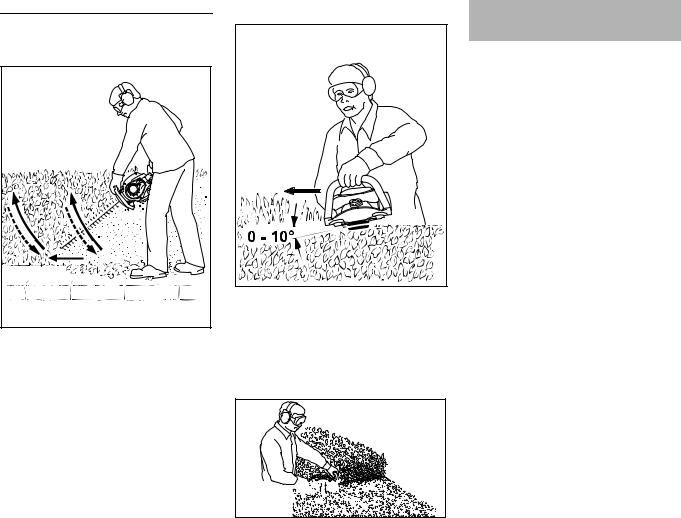
Working Technique
Vertical cut
0008BA003 KN |
Swing the cutting blade from the bottom upwardsinanarc–lowerthenoseofthe blade, move along the hedge and then swing the blade up again in an arc.
Any working position above head height is tiring. To minimize the risk of accidents, work in such positions for short periods only.
Horizontal cut
0008BA004 KN |
Hold the cutter bar at an angle of 0° to 10° as you swing the hedge trimmer horizontally.
Swing the cutting blade in an arc towards the outside of the hedge so that the cuttings are swept to the ground.










































































 0008BA005 KN
0008BA005 KN
Repeat the procedure several times on wide hedges.
English
Fuel
This engine is certified to operate on unleaded gasoline and the STIHL twostroke engine oil at a mix ratio of 50:1.
Your engine requires a mixture of highquality gasoline and two-stroke air cooled engine oil.
Usemid-gradeunleadedgasolinewitha minimum octane rating of 89 ((R+M)/2) and no more than 10% ethanol content.
Fuel with a lower octane rating may increase engine temperatures. This, in turn, increases the risk of piston seizure and damage to the engine.
The chemical composition of the fuel is also important. Some fuel additives not only detrimentally affect elastomers (carburetor diaphragms, oil seals, fuel lines,etc.),butmagnesiumcastingsand catalytic converters as well. This could cause running problems or even damage the engine. For this reason STIHL recommends that you use only high-quality unleaded gasoline!
Gasoline with an ethanol content of more than 10% can cause running problems and major damage in engines with a manually adjustable carburetor and should not be used in such engines.
The ethanol content in gasoline affects engine running speed – it may be necessary to readjust the carburetor if you use fuels with various ethanol contents.
HS 46, HS 46 C, HS 56 C |
11 |

English
 WARNING
WARNING
To reduce the risk of personal injury from loss of control and/or contact with the running cutting tool, do not use your unit with incorrect idle adjustment. At correct idle speed, the cutting tool should not move.
Ifyourpowertoolshowsanincorrectidle adjustment, have your STIHL dealer check your power tool and make proper adjustments and repairs.
The idle speed and maximum speed of the engine change if you switch from a fuel with a certain ethanol content to another fuel with a much higher or lower ethanol content.
This problem can be avoided by always using fuel with the same ethanol content.
Use only STIHL two-stroke engine oil or equivalent high-quality two-stroke engine oils that are designed for use only in air cooled two-cycle engines.
WerecommendSTIHLHPUltra2-Cycle Engine Oil since it is specially formulated for use in STIHL engines.
Do not use BIA or TCW rated (twostroke water cooled) mix oils or other mixoilsthatstatetheyareforuseinboth water cooled and air cooled engines (e.g., outboard motors, snowmobiles, chain saws, mopeds, etc.).
 WARNING
WARNING
Take care when handling gasoline. Avoid direct contact with the skin and avoid inhaling fuel vapor. When filling at the pump, first remove the container from your vehicle and place the
containeronthegroundbeforefilling.To reduce the risk of sparks from static discharge and resulting fire and/or explosion, do not fill fuel containers that are sitting in or on a vehicle or trailer.
The container should be kept tightly closed in order to limit the amount of moisture that gets into the mixture.
The machine‘s fuel tank should be cleaned as necessary.
Fuel mix ages
Only mix sufficient fuel for a few days work,nottoexceed3monthsofstorage. Store in approved fuel-containers only. When mixing, pour oil into the container first, and then add gasoline. Close the container and shake it vigorously by hand to ensure proper mixing of the oil with the fuel.
Gaso- |
Oil (STIHL 50:1 or equiva- |
line |
lent high-quality oils) |
US gal. |
US fl.oz. |
12.6
2 1/2 |
6.4 |
512.8
Dispose of empty mixing-oil containers only at authorized disposal locations.
Fueling
Preparations
0008BA025 KN
NBefore fueling, clean the filler cap andtheareaaroundittoensurethat no dirt falls into the tank.
Always thoroughly shake the mixture in the canister before fueling your machine.
NPosition the machine so that the filler cap is facing up.
 WARNING
WARNING
In order to reduce the risk of fire and personalinjuryfromescaping gasvapor and fumes, remove the fuel filler cap carefully so as to allow any pressure build-up in the tank to release slowly
12 |
HS 46, HS 46 C, HS 56 C |
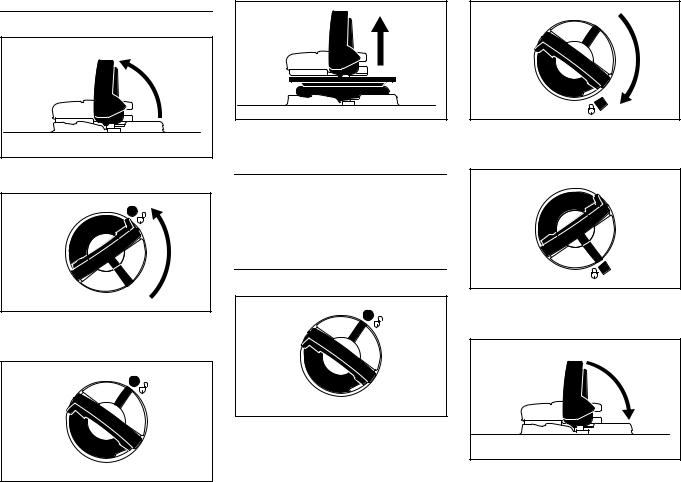
Opening
001BA236 KN
N Raise handle.
001BA232 KN
NTwist filler cap counterclockwise (approx. 1/4 turn).
001BA234 KN
Markings on filler cap and housing must align.
English
001BA237 KN
N Remove the filler cap.
Refueling
Take care not to spill fuel while fueling and do not overfill the tank – leave approx. 1/2" (13 mm) air space.
Closing
001BA234 KN
Handle is in an upright position:
NPositionfillercap–markingsonfiller cap and housing must align.
NPush the filler cap down as far as it will go.
001BA233 KN
NPush the filler cap down and twist it clockwise until it engages.
001BA231 KN
Then the markings on filler cap and housing will align.
001BA235 KN
N Flip the handle down.
HS 46, HS 46 C, HS 56 C |
13 |
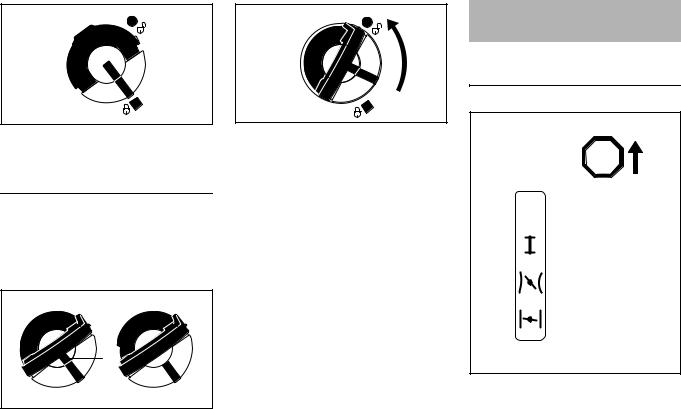
English
001BA241 KN
Filler cap is now closed.
If the filler cap will not engage into the tank housing
The base of the filler cap is rotated in relation to the upper part.
NLook at the black alignment marks on the top of the filler cap.
|
1 |
|
001BA238KN |
Left: |
Base of filler cap is rotated – |
|
interiormarking(1)isaligned |
|
with the exterior marking. |
Right: |
Base of filler cap is in the cor- |
|
rect position – interior |
|
marking is below the clip. It |
|
does not align with the exte- |
|
rior marking. |
001BA239 KN
NWith the filler cap in the filling neck, twist it counterclockwise until it drops into its seat.
NContinue to twist the filler cap counterclockwise (approx. 1/4 turn)
– this will twist the base of the cap into the correct position.
NWhile pushing down on the cap, twist the filler cap clockwise and close it – see section "Closing."
Starting / Stopping the
Engine
Positions and Functions of Master
Control Lever
STOP
0
0008BA007 KN
STOP or †– Master Control lever must be pushed in direction of STOP or †to switch off the ignition. When released, the Master Control lever springs back to thenormalrunposition Fandtheignition is switched on again.
Normal run position F– engine runs or can fire.
Starting throttle n – this position is usedtostartawarmengine.TheMaster Control lever moves to the normal run position Fwhen the throttle trigger is squeezed.
14 |
HS 46, HS 46 C, HS 56 C |
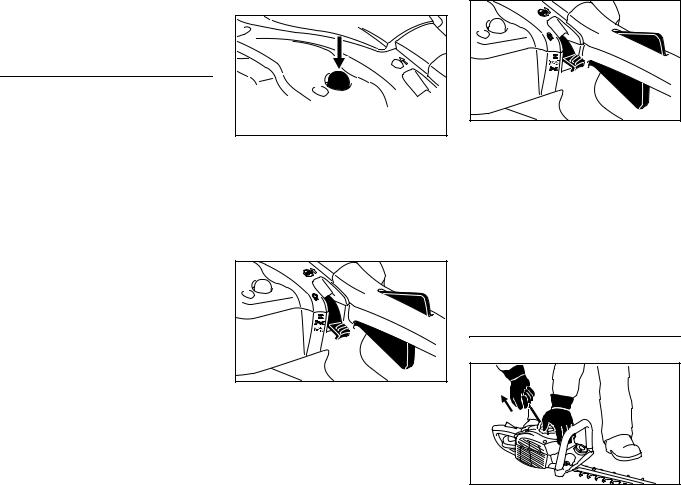
Choke closed l– this position is used to start a cold engine. The Master Control lever moves to the normal run position Fwhen the throttle trigger is squeezed.
Setting the Master Control Lever
To move the Master Control lever from thenormalrunpositionFtochokeclosed l, press down the throttle trigger lockout and squeeze the throttle trigger at the same time and hold them in that position – now set the Master Control lever.
To select the starting throttle position n, move the Master Control
lever to choke closed lfirst, then push it into the starting throttle position n.
The Master Control lever moves from the starting throttle position nor choke closed position lto the normal run position Fwhen you press down the throttle trigger lockout and blip the throttle trigger at the same time.
To switch off the engine, move the Master Control lever in the direction of STOPor†–whenreleased,theMaster Control lever springs back to the normal run position F.
English
Starting the Engine |
Warm engine (warm start) |










 0008BA008 KN
0008BA008 KN
NPress the fuel pump bulb at least five times – even if the bulb is filled with fuel.
NSet the Master Control lever to suit the engine temperature.
Cold engine (cold start)
1 |
|
|
3 |
KN |
|
0008BA009 |
||
2 |
NDepress the throttle trigger lockout (1) and the throttle trigger (2) at the same time – hold both levers in that position.
NMovetheMasterControllever (3)to l.
NRelease the throttle trigger lockout (1), throttle trigger (2) and Master Control lever.
1 |
|
3 |
KN |
2 |
0008BA010 |
NDepress the throttle trigger lockout (1) and the throttle trigger (2) at the same time – hold both levers in that position.
NMovetheMasterControllever (3)to n.
NRelease the throttle trigger lockout (1), throttle trigger (2) and Master Control lever.
Also use this setting if the engine has been running but is still cold.
Starting
0008BA011 KN
N Place the unit on the ground.
NRemovethebladescabbard.Check that the cutting blades are not touching the ground or any other obstacles.
HS 46, HS 46 C, HS 56 C |
15 |
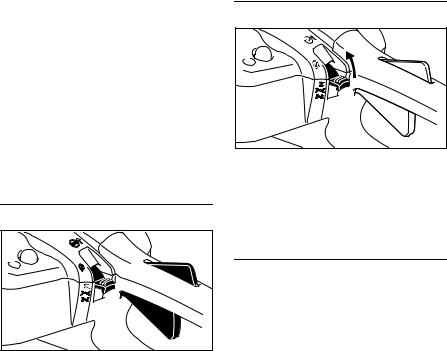
English
NMake sure you have a safe and secure footing.
NHold the unit firmly with your left hand on the fan housing and press down.
NHold the starter grip with your right hand.
Version without Easy2Start
NPull the starter grip slowly until you feelitengageandthengiveitabrisk strong pull.
NOTICE
Do not pull out the starter rope all the way – it might otherwise break.
NDonotletthestartergripsnapback. Guideitslowlybackintothehousing so that the starter rope can rewind properly.
Version with Easy2Start
N Pull the starter grip steadily.
As soon as the engine runs
0008BA012 KN |
NPress down the throttle trigger lockout and open the throttle – the Master Control lever moves to the
run position F. After a cold start, warm up the engine by opening the throttle several times.
 WARNING
WARNING
Make sure the carburetor is correctly adjusted. The cutting attachment must not rotate when the engine is idling.
Your machine is now ready for operation.
Shut off the engine.
0008BA013 KN |
NMovetheMasterControlleverinthe direction of STOP or †– when released, the Master Control lever springs back to the normal run position F.
Other hints on starting
Engine stalls in cold start position lor under acceleration
NMovetheMasterControlleverton and continue cranking until the engine runs.
Engine does not start in warm start position n.
NMovetheMasterControllevertol and continue cranking until the engine runs.
If the engine does not start
N Check that all settings are correct.
NCheck that there is fuel in the tank and refuel if necessary.
NCheck that the spark plug boot is properly connected.
N Repeat the starting procedure.
Fuel tank run until completely dry
NAfter refueling, press the fuel pump bulb at least five times – even if the bulb is filled with fuel.
NSet the Master Control lever to suit the engine temperature.
N Start the engine.
16 |
HS 46, HS 46 C, HS 56 C |
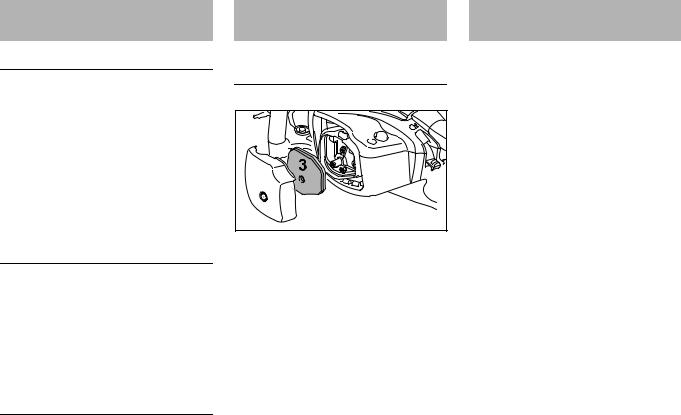
Operating Instructions
During break-in period
A factory-new machine should not be run at high revs (full throttle off load) for the first three tank fillings. This avoids unnecessary high loads during the break-in period. As all moving parts have to bed in during the break-in period, the frictional resistances in the engine are greater during this period. The engine develops its maximum power after about 5 to 15 tank fillings.
During Operation
After a long period of full throttle operation, allow the engine to run for a short while at idle speed so that engine heat can be dissipated by the flow of cooling air. This protects enginemounted components (ignition, carburetor) from thermal overload.
After Finishing Work
Storing for a short period: Wait for the enginetocooldown.Emptythefueltank and keep the machine in a dry place, well away from sources of ignition, until you need it again. For longer out-of- service periods – see "Storing the Machine".
Cleaning the Air Filter
If there is a noticeable loss of engine power
2 |
KN |
|
1 |
||
0008BA014 |
||
|
NLoosen the captive screw (1) and remove the filter cover (2).
NClean away loose dirt from around the filter.
N Remove the filter element (3).
NFit a new filter element. As a temporarymeasureyoucanknockit outonthepalmofyourhandorblow it out with compressed air. Do not wash.
N Replace any damaged parts. N Fit the filter element (3).
NFit the filter cover (2) and screw it down firmly.
English
Engine Management
Exhaust emissions are controlled by the design of the fundamental engine parameters and components (e.g. carburation, ignition, timing and valve or port timing) without the addition of any major hardware.
HS 46, HS 46 C, HS 56 C |
17 |
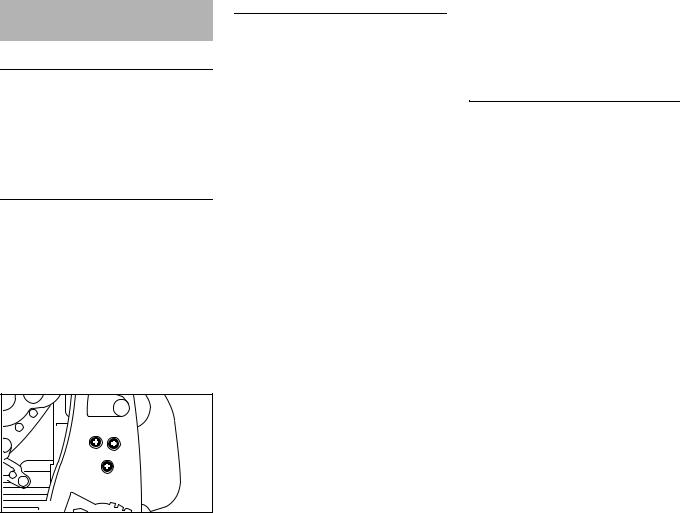
English
Adjusting the Carburetor
General Information
The carburetor comes from the factory with a standard setting.
Thissettingprovidesanoptimumfuel-air mixture under most operating conditions.
Standard Setting
N Shut off the engine.
NInspect cutting blades and clean if necessary (clean, move freely, not warped).
NCheck the air filter and clean or replace if necessary.
NCheck the spark arresting screen (not in all models, country-specific) in the muffler and clean or replace if necessary.
L H
|
KN |
LA |
0008BA016 |
|
NTurn high speed screw (H) counterclockwise as far as stop (no more than 3/4 turn).
NTurn the low speed screw (L) carefully clockwise as far as stop, then turn it back 3/4 turn.
Adjusting Idle Speed
N Carry out the standard setting. N Start and warm up the engine.
Engine stops while idling
NTurn the idle speed screw (LA) clockwise until the cutting blades begin to run – then back it off about 1 full turn.
Cutting blades run when engine is idling
NTurn the idle speed screw (LA) counterclockwise until the cutting blades stop moving – then turn it another 1 full turn in the same direction.
 WARNING
WARNING
If the cutting blades continue moving when the engine is idling, have your hedge trimmer checked and repaired by your servicing dealer.
Erraticidlingbehavior,pooracceleration (despite correction to setting of LA screw).
Idle setting is too lean
NRotate the low speed screw (L) about 1/4 turncounterclockwise,no further than stop, until the engine runs and accelerates smoothly.
Machine stops when it is swung at idle speed
Idle setting is too rich
NRotate the low speed screw (L) about 1/4 turn clockwise until the engine idles smoothly.
It is usually necessary to change the settingoftheidlespeedscrew (LA)after every correction to the low speed screw (L).
Fine Tuning for Operation at High Altitude
A slight correction of the setting may be necessary if engine does not run satisfactorily:
N Carry out the standard setting. N Warm up the engine.
NTurn high speed screw (H) slightly clockwise (leaner) – no further than stop.
NOTICE
After returning from high altitude, reset the carburetor to the standard setting.
If the setting is too lean there is a risk of engine damage due to insufficient lubrication and overheating.
18 |
HS 46, HS 46 C, HS 56 C |
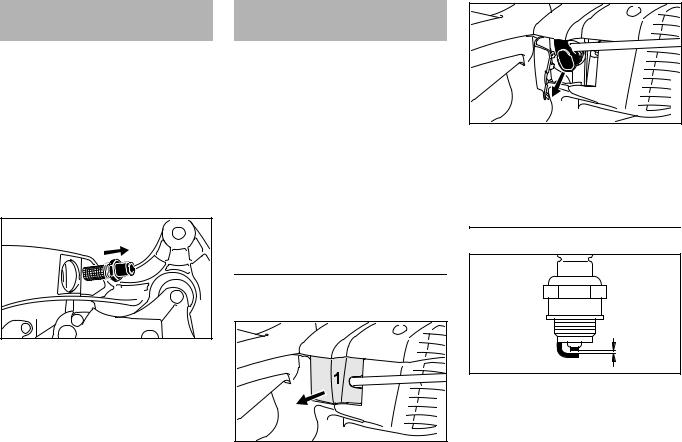
Spark Arresting Screen in
Muffler
In some countries the muffler is equipped with a spark arresting screen.
NIf the engine is down on power or maximum speed is irregular, check the spark arresting screen in the muffler.
 WARNING
WARNING
Wait for the engine to cool down completely before performing this work.
0008BA015 KN
NUse a 15 mm socket wrench to unscrew the spark arresting screen.
NClean the spark arresting screen. If the screen is damaged or heavily carbonized, fit a new one.
NRefitthesparkarrestingscreenand tighten it down firmly.
Checking the Spark Plug
If engine is down on power, difficult to start or runs poorly at idling speed, first check the spark plug.
Fit a new spark plug after approx. 100 operating hours or earlier if the electrodes are badly eroded.
Wrong fuel mix (too much engine oil in the gasoline), a dirty air filter and unfavorable running conditions (mostly at part throttle etc.) affect the condition of the spark plug. These factors cause deposits to form on the insulator nose which may result in trouble in operation.
Removing the Spark Plug
N Stopping the Engine
0008BA017 KN |
NCarefullypryopentheflap (1)witha suitable tool (e.g. combination wrench).
English |
2 |
0008BA018 KN |
NRemove the spark plug boot (2) using a suitable tool (e.g. combination wrench).
N Unscrew the spark plug.
Checking the Spark Plug
|
KN |
A |
000BA039 |
|
N Clean dirty spark plug.
NCheck electrode gap (A) and readjust if necessary – see "Specifications."
NUseonlyresistortypesparkplugsof the approved range.
Rectify problems that have caused fouling of spark plug:
–too much oil in fuel mix,
–dirty air filter,
–unfavorablerunningconditions,e.g. operating at part load.
HS 46, HS 46 C, HS 56 C |
19 |
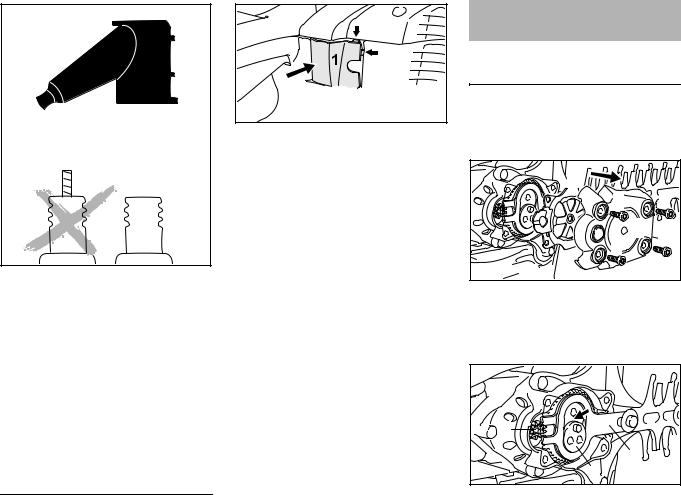
English
1
 2
2
000BA071 KN
 WARNING
WARNING
Toreducetheriskoffireandburninjury, use only spark plugs authorized by STIHL.Alwayspresssparkplugboot(1) snuglyontosparkplugterminal(2)ofthe proper size. (Note: If terminal has detachable SAE adapter nut, it must be securely attached.) A loose connection between spark plug boot and ignition wire connector in the boot may create arcing that could ignite combustible fumes and cause a fire.
Installing the Spark Plug
NInsert and screw home the spark plug by hand.
N Tighten down the spark plug.
NPress the spark plug boot firmly onto the spark plug.







 0008BA019 KN
0008BA019 KN
NClose the flap (1), top first, then the bottom, tabs (arrows) must snap into position.
Lubricating the Gearbox
Commercial usage only – check every 25 hours of operation
Use STIHL gear lubricant for hedgetrimmers (special accessory) to lubricate the blade drive gear.
2 |
|
1 |
1 |
3 |
1 KN |
1 |
0008BA020 |
|
NRemove the screws (1) from the underside of the unit.
NRemove the retaining plate (2) and gearbox cover (3).
6 |
|
KN |
|
|
|
4 |
5 |
0008BA021 |
|
NSqueeze grease into the gearbox housing (arrow) between the cam (4) and cutting blade (5) a little at a time (max.1/4 oz (5 g)) while turning the drive pinion (6) with an hex key wrench to distribute the grease evenly – avoid contact with the cutting blades.
20 |
HS 46, HS 46 C, HS 56 C |

NOTICE
Do not completely fill the gearbox with grease.
2 |
|
1 |
1 |
3 |
1 KN |
1 |
0008BA022 |
|
NFit the retaining plate (2) so that it is flush with the gearbox housing.
NFit the gearbox cover (3), insert the screws (1) and tighten them down firmly.
Rewind Starter
To help prolong the wear life of the starter rope, observe the following points:
NPull the starter rope only in the direction specified.
NDonotpulltheropeovertheedgeof the guide bushing.
NDo not pull out the rope more than specified.
NDo not allow the starter grip to snap back, guide it back into the housing slowly – see chapter on "Starting / Stopping the Engine."
Have a damaged starter rope replaced by your dealer before it breaks completely. STIHL recommends that you have servicing and repair work carried out exclusively by an authorized STIHL servicing dealer.
English
Storing the Machine
For periods of 3 months or longer
NClean the cutting blades, check condition and spray them with STIHL resin solvent.
NDrain and clean the fuel tank in a well ventilated area.
NDispose of fuel properly in accordance with local environmental requirements.
NRun the engine until the carburetor is dry – this helps prevent the carburetor diaphragms sticking together.
N Fit the blade scabbard.
NThoroughlycleanthemachine–pay special attention to the cylinder fins and air filter.
NStore the machine in a dry and safe location (use the ring integrated in therearhandle)–outofthereachof children and other unauthorized persons.
HS 46, HS 46 C, HS 56 C |
21 |
